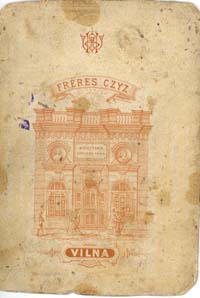Sign up for the Family Tree Newsletter Plus, you’ll receive our 10 Essential Genealogy Research Forms PDF as a special thank you!
Get Your Free Genealogy Forms
"*" indicates required fields
I love a challenge, so I was happy to see Christean Jenkins’ photo in my e-mail inbox. All she knows about this charming portrait is what her great-uncle wrote on the envelope when he sent it to her father more than 25 years ago: “Our relation in the old country.” That’s it.
The back of the photo helps more than the front in this case. The photographer’s imprint suggests a date. Design elements on imprints went in and out of vogue; the elaborate engraving on this one is from the 1870s. That date is confirmed by the full bustles and lace collars on the women in the design.
During this time, imprints usually included a photographer’s name or studio and town. This holds true around the world, which makes it easy to decipher the significance of the wording, even in another language. Here, I’m looking for a prominent name and place. I know from its position at the top of the card that Freres Czyz refers to the photographer and Vilna is the location of the studio.
Since Jenkins wants to know where the picture was taken, I did a Google search on Vilna, then refined it to include definition. I got a gazetteer-like description from the Dayton Holocaust Research Center. Vilna, the capital of Lithuania, “has been part of Russia, Poland, Lithuania, Sweden and the realm of the Teutonic Knights.” And here’s a clue to the imprint’s language: “from 1795 to 1915 it was under Russian control, and during that period flourished as a center of rabbinic studies.”
Next, I used Google to look for information on the photographer. In French, freres means brothers, but a search in online Lithuanian/English or Russian/English dictionaries doesn’t add any new meaning. Again using Google, I typed in surname Czyz, but nothing pertinent turned up. 
There were still two pieces of evidence to research: the writing on the building in the imprint, and the uniforms worn by the boys in the photo. Since Vilna was in Lithuania but under Russian control, I ran a Google image search for Lithuanian alphabet and “Russian alphabet.” Pictures of the Lithuanian alphabet and Russian alphabet indicate the words on the building are Russian. In similar imprints US photographers used, words on a building give the name of the structure housing the studio. Translating the name in this imprint would probably give Jenkins an address for the photographer.
It’s possible the boys pictured are wearing military school uniforms. Using Google’s image search, I find Costumer’s Manifesto, which profiles a Catherine Palace & Park Cameron Gallery (Tsarkoe Selo, Russia) exhibit on Russian costumes from the late 1700s to the early 1900s. It’s just a beginning; more research is needed to establish exactly what uniform these boys are wearing. Jenkins could contact the Company of Military Historians and ask for names of experts on 19th-century Russian uniforms.
An unidentified foreign picture doesn’t have to remain unsolved. if you piecing together information on the back and front of the photo. And since Jenkins has completed a lot of family history, she’ll probably be able to name these boys by finding a link between immigrants in the United States and family in the “old country.” <!–
Watch for props. –><!–
2000–>
ADVERTISEMENT

